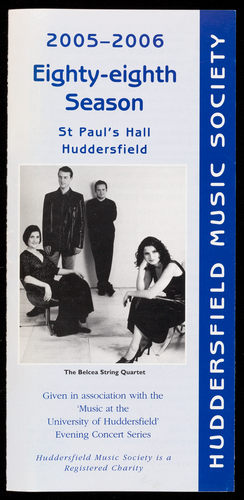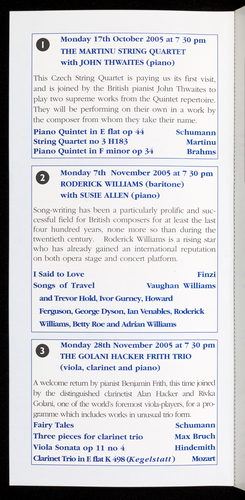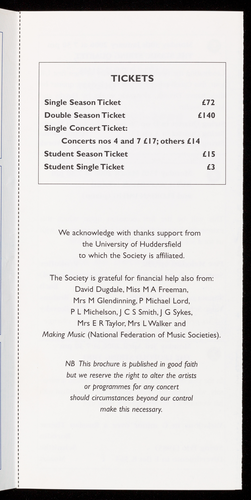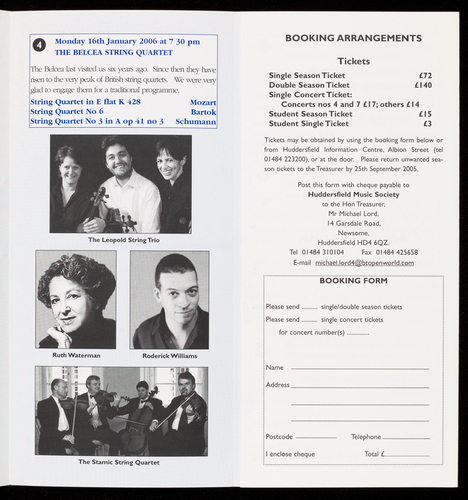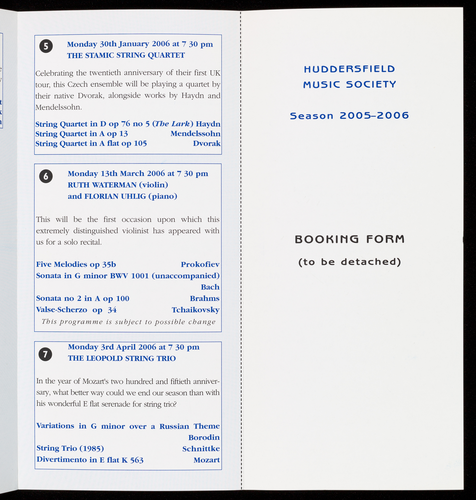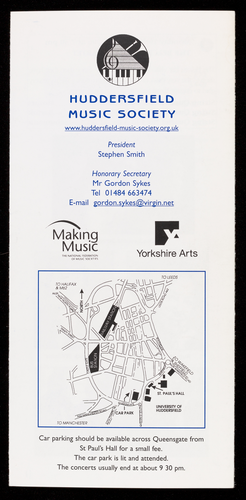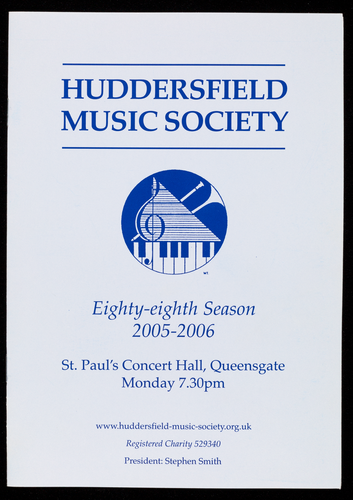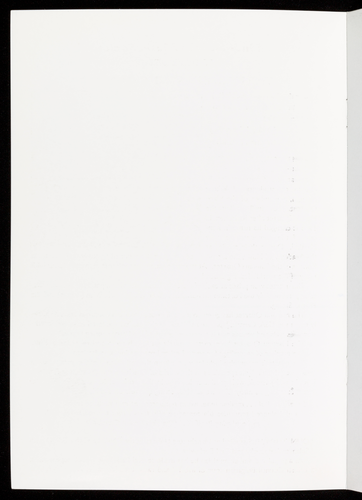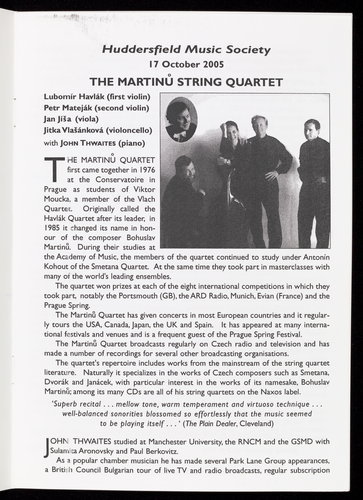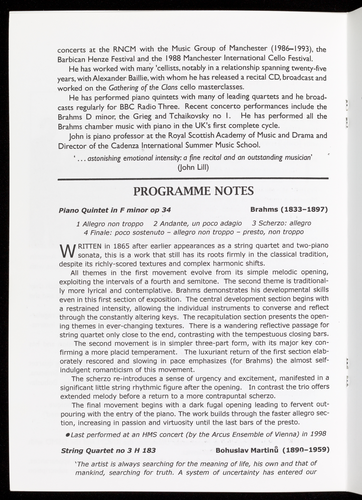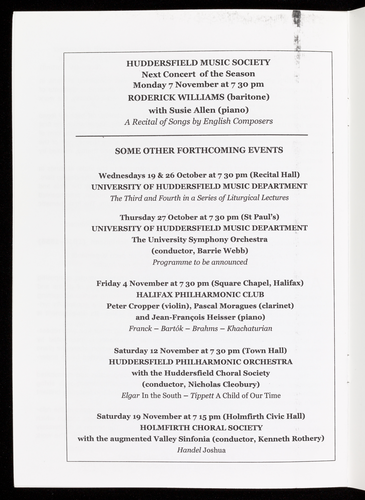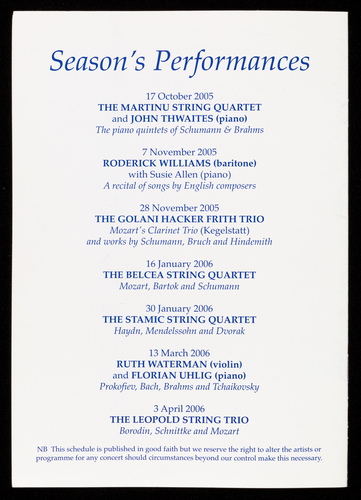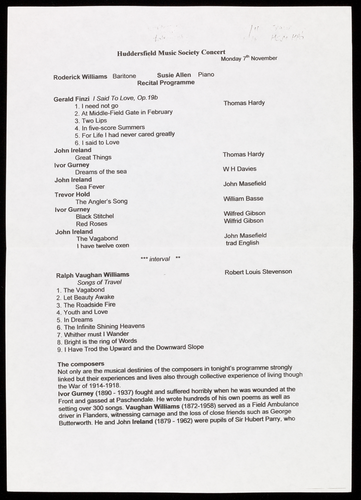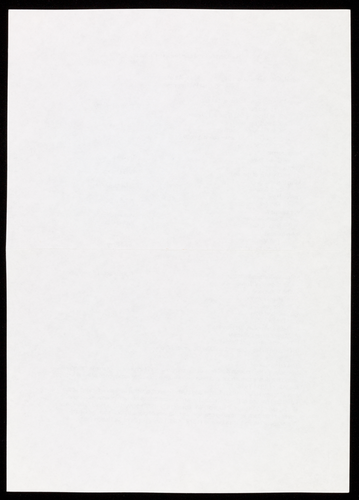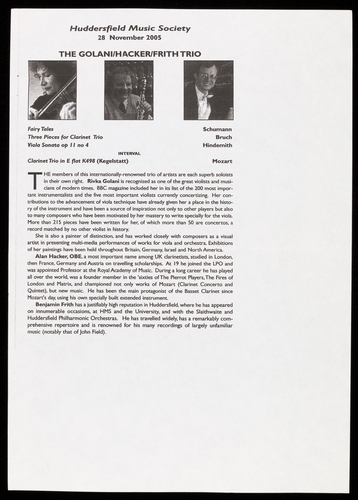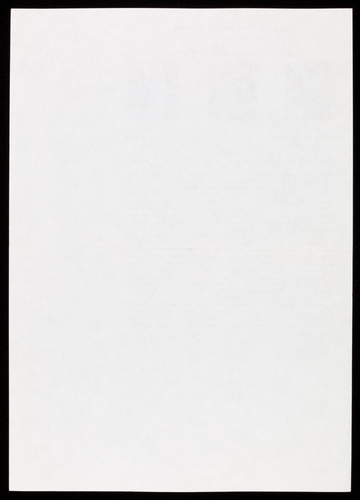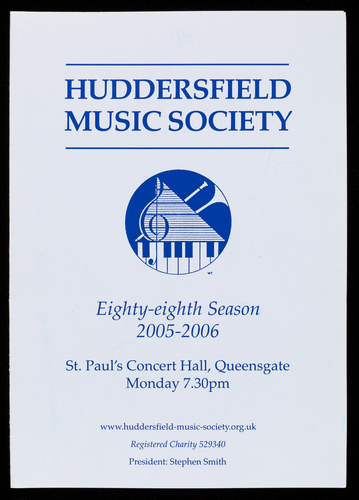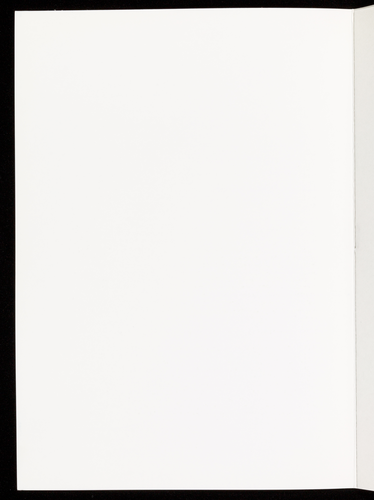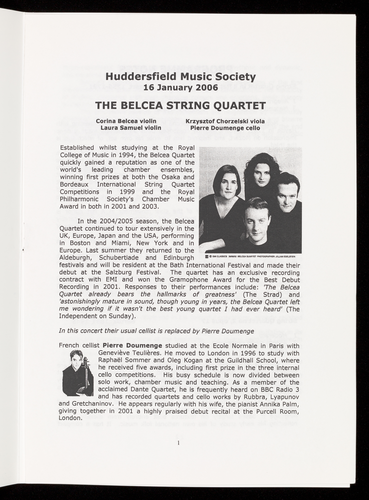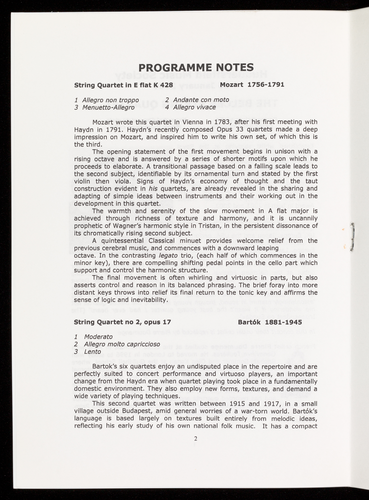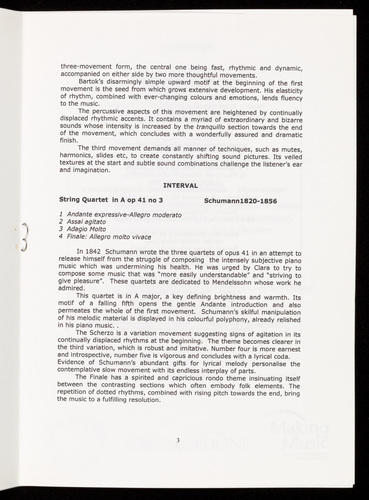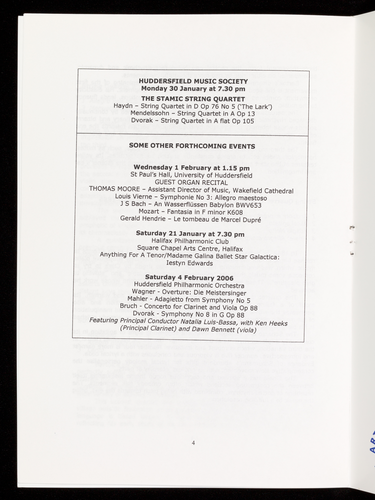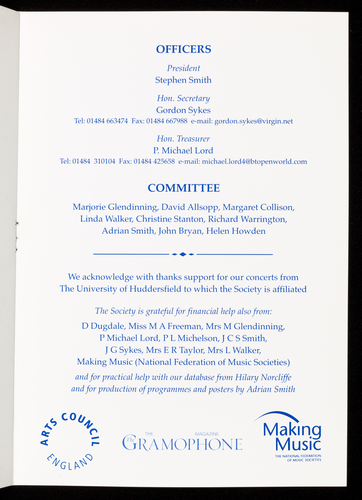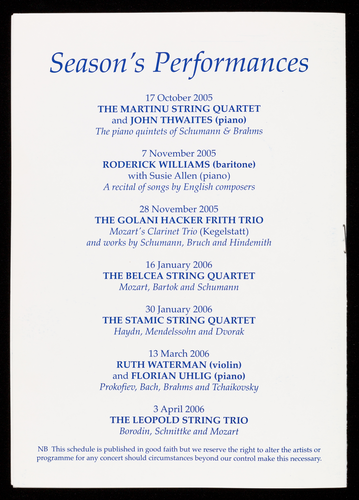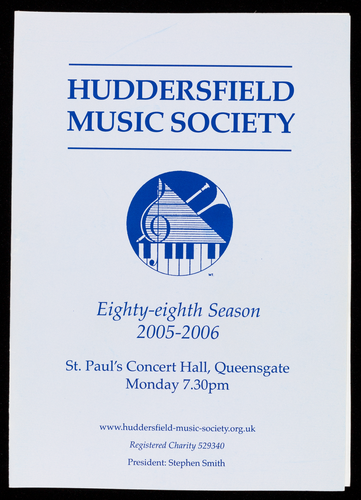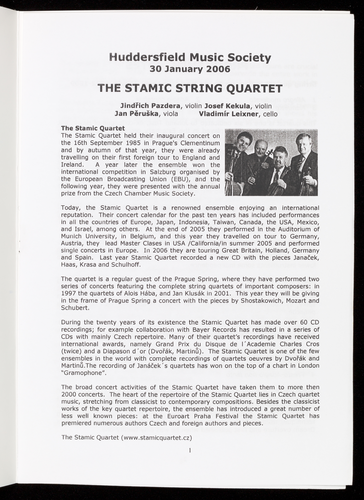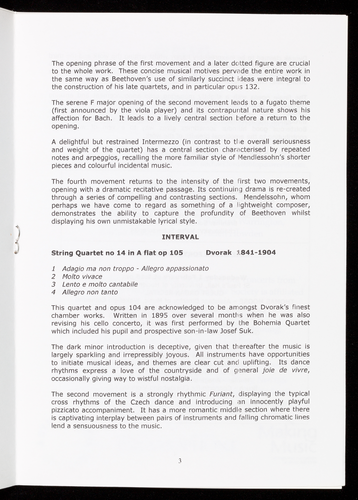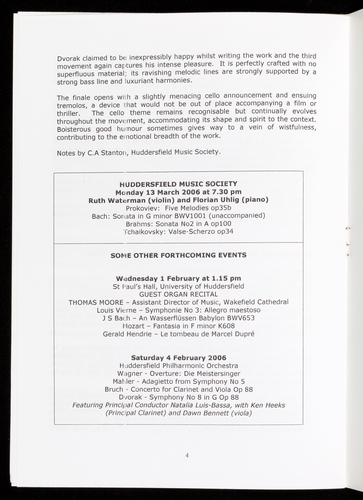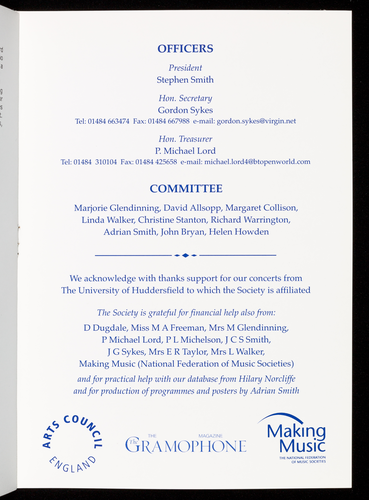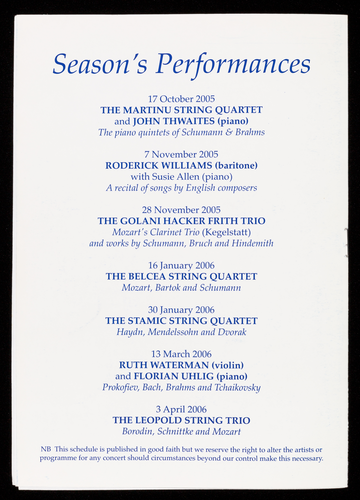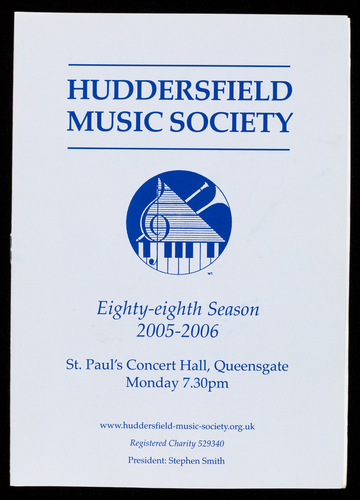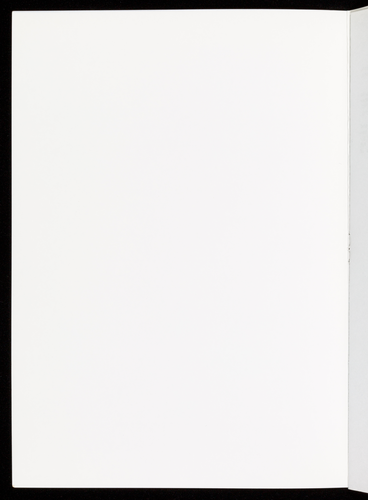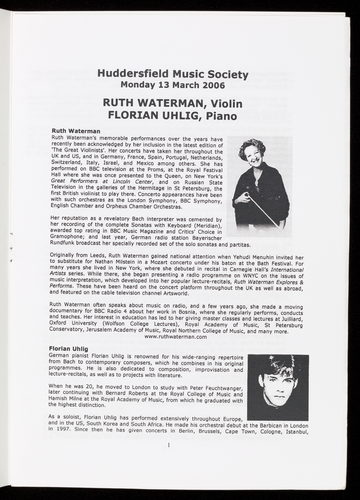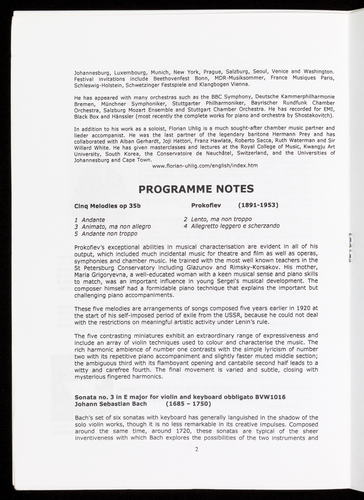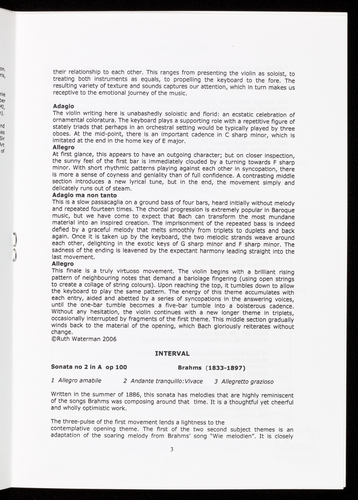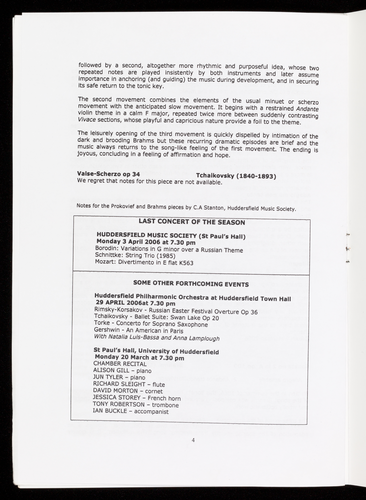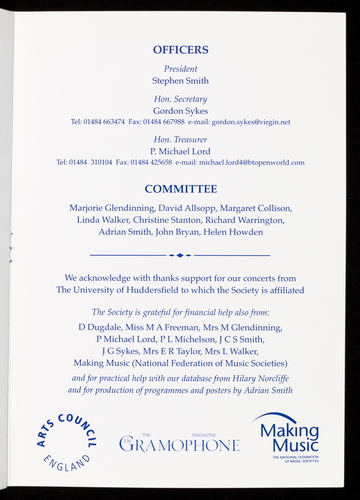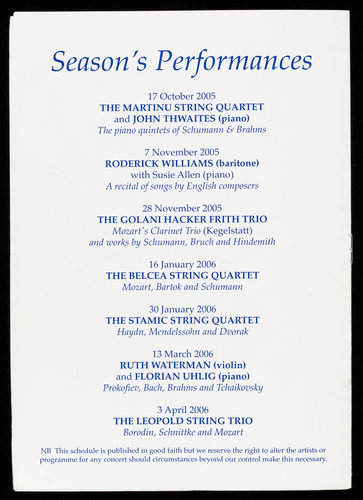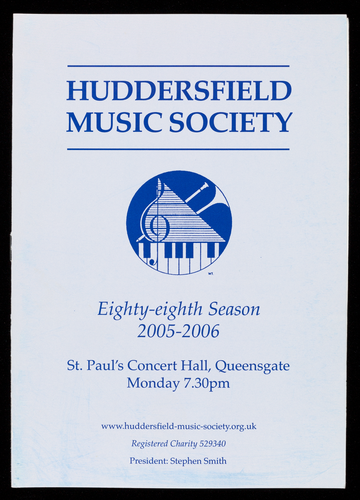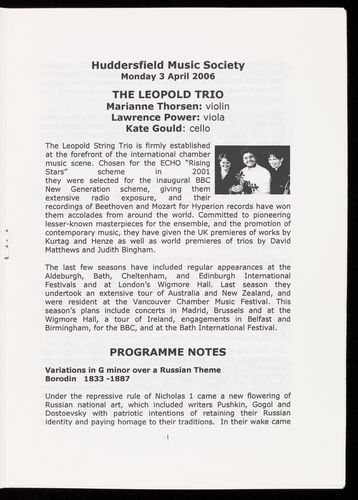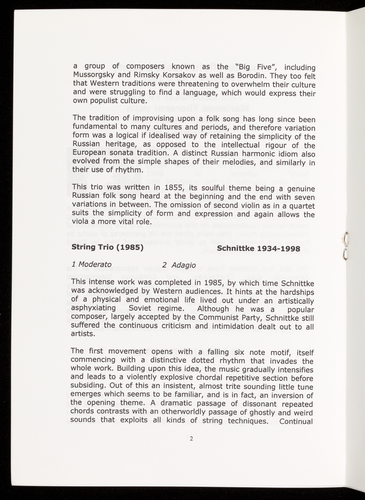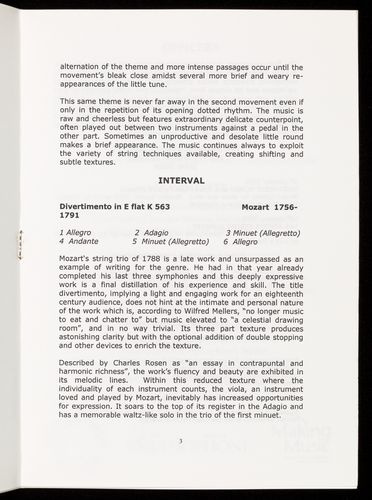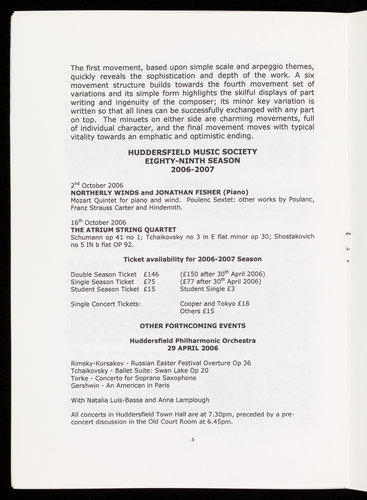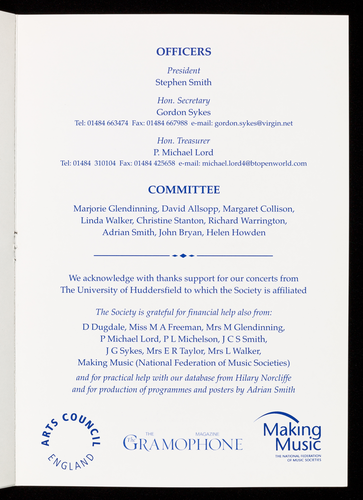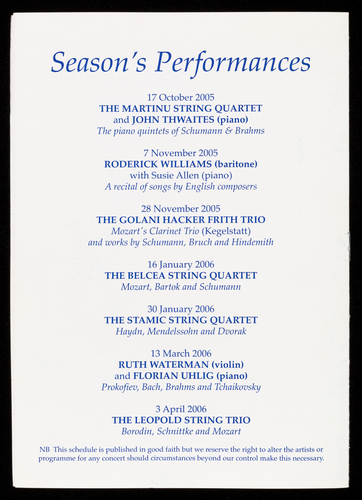Ocr'd Text:
2005-2006
Eighty-eighth
Season
St Paul's Hall
Huddersfield
The Belcea String Quartet
Given in association with the
'Music at the
University of Huddersfield'
Evening Concert Series
Huddersfield Music Society is a
Registered Charity
HUDDERSFIELD MUSIC SOCIETY
Ocr'd Text:
D
This Czech String Quartet is paying us its first visit,
and is joined by the British pianist John Thwaites to
play two supreme works from the Quintet repertoire.
They will be performing on their own in a work by
the composer from whom they take their name.
Monday 17th October 2005 at 7 30 pm
THE MARTINU STRING QUARTET
with JOHN THWAITES (piano)
Piano Quintet in E flat op 44
String Quartet no 3 H183
Piano Quintet in F minor op 34
2
3
Schumann
Martinu
Brahms
Monday 7th November 2005 at 7 30 pm
RODERICK WILLIAMS (baritone)
with SUSIE ALLEN (piano)
Song-writing has been a particularly prolific and suc-
cessful field for British composers for at least the last
four hundred years, none more so than during the
twentieth century. Roderick Williams is a rising star
who has already gained an international reputation
on both opera stage and concert platform.
I Said to Love
Songs of Travel
and Trevor Hold, Ivor Gurney, Howard
Ferguson, George Dyson, Ian Venables, Roderick
Williams, Betty Roe and Adrian Williams
Finzi
Vaughan Williams
Monday 28th November 2005 at 7 30 pm
THE GOLANI HACKER FRITH TRIO
(viola, clarinet and piano)
A welcome return by pianist Benjamin Frith, this time joined
by the distinguished clarinetist Alan Hacker and Rivka
Golani, one of the world's foremost viola-players, for a pro-
gramme which includes works in unusual trio form.
Fairy Tales
Three pieces for clarinet trio
Viola Sonata op 11 no 4
Clarinet Trio in E flat K 498 (Kegelstatt)
Schumann
Max Bruch
Hindemith
Mozart
Ocr'd Text:
TICKETS
Single Season Ticket
Double Season Ticket
Single Concert Ticket:
Concerts nos 4 and 7 £17; others £14
Student Season Ticket
Student Single Ticket
£72
£140
We acknowledge with thanks support from
the University of Huddersfield
to which the Society is affiliated.
NB This brochure is published in good faith
but we reserve the right to alter the artists
or programmes for any concert
should circumstances beyond our control
make this necessary.
£15
£3
The Society is grateful for financial help also from:
David Dugdale, Miss M A Freeman,
Mrs M Glendinning, P Michael Lord,
PL Michelson, J C S Smith, JG Sykes,
Mrs E R Taylor, Mrs L Walker and
Making Music (National Federation of Music Societies).
Ocr'd Text:
4
Monday 16th January 2006 at 7 30 pm
THE BELCEA STRING QUARTET
The Belcea last visited us six years ago. Since then they have
risen to the very peak of British string quartets. We were very
glad to engage them for a traditional
them for a traditional programme.
String Quartet in E flat K 428
String Quartet No 6
String Quartet No 3 in A op 41 no 3
The Leopold String Trio
Ruth Waterman
Mozart
Bartok
Schumann
Roderick Williams
The Stamic String Quartet
BOOKING ARRANGEMENTS
Single Season Ticket
Double Season Ticket
Single Concert Ticket:
Concerts nos 4 and 7 £17; others £14
Student Season Ticket
Student Single Ticket
Name
Tickets
Tickets may be obtained by using the booking form below or
from Huddersfield Information Centre, Albion Street (tel
01484 223200), or at the door. Please return unwanted sea-
son tickets to the Treasurer by 25th September 2005.
Address
Post this form with cheque payable to
Huddersfield Music Society
Postcode
to the Hon Treasurer,
Mr Michael Lord,
14 Garsdale Road,
Newsome,
Huddersfield HD4 6QZ.
Tel 01484 310104
Please send ........... single/double season tickets
Please send ........... single concert tickets
for concert number(s)...............
I enclose cheque
Fax 01484 425658
E-mail michael.lord4@btopenworld.com
BOOKING FORM
£72
£140
Telephone
Total £........
£15
£3
Ocr'd Text:
t
X
5
Celebrating the twentieth anniversary of their first UK
tour, this Czech ensemble will be playing a quartet by
their native Dvorak, alongside works by Haydn and
Mendelssohn.
Monday 30th January 2006 at 7 30 pm
THE STAMIC STRING QUARTET
String Quartet in D op 76 no 5 (The Lark) Haydn
String Quartet in A op 13
Mendelssohn
String Quartet in A flat op 105
Dvorak
6
Monday 13th March 2006 at 7 30 pm
RUTH WATERMAN (violin)
and FLORIAN UHLIG (piano)
This will be the first occasion upon which this
extremely distinguished violinist has appeared with
us for a solo recital.
Five Melodies op 35b
Sonata in G minor BWV 1001 (unaccompanied)
7
Prokofiev
Sonata no 2 in A op 100
Valse-Scherzo op 34
Tchaikovsky
This programme is subject to possible change
Bach
Brahms
Monday 3rd April 2006 at 7 30 pm
THE LEOPOLD STRING TRIO
In the year of Mozart's two hundred and fiftieth anniver-
sary, what better way could we end our season than with
his wonderful E flat serenade for string trio?
String Trio (1985)
Divertimento in E flat K 563
Variations in G minor over a Russian Theme
Borodin
Schnittke
Mozart
HUDDERSFIELD
MUSIC SOCIETY
Season 2005-2006
BOOKING FORM
(to be detached)
Ocr'd Text:
HUDDERSFIELD
A629
MUSIC SOCIETY
www.huddersfield-music-society.org.uk
President
Stephen Smith
Making
Music
Honorary Secretary
Mr Gordon Sykes
Tel 01484 663474
E-mail gordon.sykes@virgin.net
THE NATIONAL FEDERATION
OF MUSIC SOCIETIES
TO HALIFAX
& M62
NEW NORTH
TRINITY STREET
-1
NORTH
A62 MANCHESTER ROAD
TO MANCHESTER
OLA
STATION
CASTLE GATE
BUS
Car parking should be
RAILWAY STATION
BOO ୦୦୮
00L
1009
00G00
A616 CHAPEL HILL
Yorkshire Arts
JAL
301
QUEESNGATE
CAR PARK
TSOUTHO
SOUTHGATE
TO LEEDS
QUEEN
LEEDS ROAD A62
TO WAKEFIELD
& SHEFFIELD
A629 WAKEFIELD ROAD
ST. PAUL'S HALL
UNIVERSITY OF
HUDDERSFIELD
available across Queensgate from
St Paul's Hall for a small fee.
The car park is lit and attended.
The concerts usually end at about 9 30 pm.
Ocr'd Text:
HUDDERSFIELD
MUSIC SOCIETY
LL
17
WT.
Eighty-eighth Season
2005-2006
St. Paul's Concert Hall, Queensgate
Monday 7.30pm
www.huddersfield-music-society.org.uk
Registered Charity 529340
President: Stephen Smith
Ocr'd Text:
Huddersfield Music Society
17 October 2005
THE MARTINŮ STRING QUARTET
Lubomír Havlák (first violin)
Petr Mateják (second violin)
Jan Jíša (viola)
Jitka Vlašánková (violoncello)
with JOHN THWAITES (piano)
HE MARTINŮ QUARTET
first came together in 1976
at the Conservatoire in
Prague as students of Viktor
Moucka, a member of the Vlach
Quartet. Originally called the
Havlák Quartet after its leader, in
1985 it changed its name in hon-
our of the composer Bohuslav
Martinů. During their studies at
the Academy of Music, the members of the quartet continued to study under Antonín
Kohout of the Smetana Quartet. At the same time they took part in masterclasses with
many of the world's leading ensembles.
The quartet won prizes at each of the eight international competitions in which they
took part, notably the Portsmouth (GB), the ARD Radio, Munich, Evian (France) and the
Prague Spring.
The Martinů Quartet has given concerts in most European countries and it regular-
ly tours the USA, Canada, Japan, the UK and Spain. It has appeared at many interna-
tional festivals and venues and is a frequent guest of the Prague Spring Festival.
The Martinů Quartet broadcasts regularly on Czech radio and television and has
made a number of recordings for several other broadcasting organisations.
The quartet's repertoire includes works from the mainstream of the string quartet
literature. Naturally it specializes in the works of Czech composers such as Smetana,
Dvorák and Janácek, with particular interest in the works of its namesake, Bohuslav
Martinů; among its many CDs are all of his string quartets on the Naxos label.
'Superb recital ... mellow tone, warm temperament and virtuoso technique ...
well-balanced sonorities blossomed so effortlessly that the music seemed
to be playing itself... (The Plain Dealer, Cleveland)
OHN THWAITES studied at Manchester University, the RNCM and the GSMD with
Sulamita Aronovsky and Paul Berkovitz.
As a popular chamber musician he has made several Park Lane Group appearances,
a British Council Bulgarian tour of live TV and radio broadcasts, regular subscription
Ocr'd Text:
concerts at the RNCM with the Music Group of Manchester (1986-1993), the
Barbican Henze Festival and the 1988 Manchester International Cello Festival.
He has worked with many 'cellists, notably in a relationship spanning twenty-five
years, with Alexander Baillie, with whom he has released a recital CD, broadcast and
worked on the Gathering of the Clans cello masterclasses.
He has performed piano quintets with many of leading quartets and he broad-
casts regularly for BBC Radio Three. Recent concerto performances include the
Brahms D minor, the Grieg and Tchaikovsky no I. He has performed all the
Brahms chamber music with piano in the UK's first complete cycle.
John is piano professor at the Royal Scottish Academy of Music and Drama and
Director of the Cadenza International Summer Music School.
... astonishing emotional intensity: a fine recital and an outstanding musician'
(John Lill)
PROGRAMME NOTES
Brahms (1833-1897)
1 Allegro non troppo 2 Andante, un poco adagio
3 Scherzo: allegro
4 Finale: poco sostenuto - allegro non troppo - presto, non troppo
Piano Quintet in F minor op 34
W
RITTEN in 1865 after earlier appearances as a string quartet and two-piano
sonata, this is a work that still has its roots firmly in the classical tradition,
despite its richly-scored textures and complex harmonic shifts.
All themes in the first movement evolve from its simple melodic opening,
exploiting the intervals of a fourth and semitone. The second theme is traditional-
ly more lyrical and contemplative. Brahms demonstrates his developmental skills
even in this first section of exposition. The central development section begins with
a restrained intensity, allowing the individual instruments to converse and reflect
through the constantly altering keys. The recapitulation section presents the open-
ing themes in ever-changing textures. There is a wandering reflective passage for
string quartet only close to the end, contrasting with the tempestuous closing bars.
The second movement is in simpler three-part form, with its major key con-
firming a more placid temperament. The luxuriant return of the first section elab-
orately rescored and slowing in pace emphasizes (for Brahms) the almost self-
indulgent romanticism of this movement.
The scherzo re-introduces a sense of urgency and excitement, manifested in a
significant little string rhythmic figure after the opening. In contrast the trio offers
extended melody before a return to a more contrapuntal scherzo.
The final movement begins with a dark fugal opening leading to fervent out-
pouring with the entry of the piano. The work builds through the faster allegro sec-
tion, increasing in passion and virtuosity until the last bars of the presto.
Last performed at an HMS concert (by the Arcus Ensemble of Vienna) in 1998
String Quartet no 3 H 183
Bohuslav Martinů (1890-1959)
'The artist is always searching for the meaning of life, his own and that of
mankind, searching for truth. A system of uncertainty has entered our
Ocr'd Text:
le
e
d
3-
e
e
d
)
0
},
1,
S
h
ct
r
a
S
)
daily life. The pressures of mechanisation and uniformity to which it is subject
call for protest and the artist has only one means of expressing this, by music.'
(Bohuslav Martinů)
ARTINU'S string quartet no 3 (in three movements) was completed in Paris in
December 1929 and dedicated to the Roth quartet. With discernible elements of
contemporary French influence and textures that occasionally recall Debussy, the work
allows the composer to explore new timbres.
The first movement, an allegro, opens with plucked cello chords, off-beat col legno
notes from the viola and a muted tremolo from the second violin, above which the first
violin introduces a motif that continues to have importance in the free sonata form of
the movement. The first violin later introduces a gentler secondary theme, part of the
basic material from which the movement is woven, urged on by one theme, relaxed by
another.
Much of the material of the following andante is entrusted to the viola, at times in
close collaboration with the cello, which assumes fuller responsibility in the closing bars.
There is something of Bartók about the third movement, opened by the viola and
impelled forwards until the same instrument introduces an easier motion, accompanied
by plucked chords from the cello and harmonics from the first violin. The first thematic
material returns, leading to a rapid final section.
This work is tonight receiving its first performance at an HMS concert.
Piano Quintet in E flat op 44
Schumann (1810-1856)
1 Allegro brillante 2 In modo d'una marcia - un poco largamente
3 Scherzo: molto vivace 4 Allegro, ma non troppo
FTER 1842 Schumann concentrated exclusively on his chamber music, composing
expressiveness make this one of his best-loved and most appealing works. An opening
chordal flourish heralds a passionate and expressive movement with a wonderfully lyri-
cal second subject based upon ascending and descending scales. Its development is
notable for the brilliant and idiomatic piano writing.
The opening theme of the second movement is in a brooding minor key, with repeat-
ed notes and limited melodic movement. Its regular appearance is interrupted by
episodes of a contrasting nature: the first, an expansive major section where the piano
is limited to an accompanying role, and the second, which is dominated by an under-
current of agitato triplet rhythms.
The scherzo starts in a mood of exhilaration with galloping scales and syncopated
responses leading to a calmer trio based on a triplet accompaniment with string
exchanges above. After a return to the scherzo there is a second trio featuring brilliant
rapid semiquavers in the minor key.
The ast movement is characterized by this same exhilaration. It opens in the rela-
tive minor key of C minor, progressing to a slightly calmer development section which
also exploits the contrapuntal possibilities of earlier themes. The tempo is deliberately
broadened and the home key of E flat is ushered in with a fugato passage. The work
concluces with an affirmative coda.
Last performed at an HMS concert
(by the Fitzwilliam String Quartet and Alan Schiller) in 1982
Ocr'd Text:
HUDDERSFIELD MUSIC SOCIETY
Next Concert of the Season
Monday 7 November at 7 30 pm
RODERICK WILLIAMS (baritone)
with Susie Allen (piano)
A Recital of Songs by English Composers
SOME OTHER FORTHCOMING EVENTS
Wednesdays 19 & 26 October at 7 30 pm (Recital Hall)
UNIVERSITY OF HUDDERSFIELD MUSIC DEPARTMENT
The Third and Fourth in a Series of Liturgical Lectures
Thursday 27 October at 7 30 pm (St Paul's)
UNIVERSITY OF HUDDERSFIELD MUSIC DEPARTMENT
The University Symphony Orchestra
(conductor, Barrie Webb)
Programme to be announced
Friday 4 November at 7 30 pm (Square Chapel, Halifax)
HALIFAX PHILHARMONIC CLUB
Peter Cropper (violin), Pascal Moragues (clarinet)
and Jean-François Heisser (piano)
Franck-Bartók - Brahms - Khachaturian
Saturday 12 November at 7 30 pm (Town Hall)
HUDDERSFIELD PHILHARMONIC ORCHESTRA
with the Huddersfield Choral Society
(conductor, Nicholas Cleobury)
Elgar In the South - Tippett A Child of Our Time
Saturday 19 November at 7 15 pm (Holmfirth Civic Hall)
HOLMFIRTH CHORAL SOCIETY
with the augmented Valley Sinfonia (conductor, Kenneth Rothery)
Handel Joshua
Ocr'd Text:
OFFICERS
President
Stephen Smith
Hon. Secretary
Gordon Sykes
Tel: 01484 663474 Fax: 01484 667988 e-mail: gordon.sykes@virgin.net
Hon. Treasurer
P. Michael Lord
Tel: 01484 310104 Fax: 01484 425658 e-mail: michael.lord4@btopenworld.com
ARTS
COMMITTEE
Marjorie Glendinning, David Allsopp, Margaret Collison,
Linda Walker, Christine Stanton, Richard Warrington,
Adrian Smith, John Bryan, Helen Howden
We acknowledge with thanks support for our concerts from
The University of Huddersfield to which the Society is affiliated
The Society is grateful for financial help also from:
D Dugdale, Miss M A Freeman, Mrs M Glendinning,
P Michael Lord, P L Michelson, JC S Smith,
JG Sykes, Mrs E R Taylor, Mrs L Walker,
Making Music (National Federation of Music Societies)
and for practical help with our database from Hilary Norcliffe
and for production of programmes and posters by Adrian Smith
COUNCIL
ENGLAND
THE
MAGAZINE
GRAMOPHONE
Making
Music
THE NATIONAL FEDERATION
OF MUSIC SOCIETIES
24
Ocr'd Text:
Season's Performances
17 October 2005
THE MARTINU STRING QUARTET
and JOHN THWAITES (piano)
The piano quintets of Schumann & Brahms
7 November 2005
RODERICK WILLIAMS (baritone)
with Susie Allen (piano)
A recital of songs by English composers
28 November 2005
THE GOLANI HACKER FRITH TRIO
Mozart's Clarinet Trio (Kegelstatt)
and works by Schumann, Bruch and Hindemith
16 January 2006
THE BELCEA STRING QUARTET
Mozart, Bartok and Schumann
30 January 2006
THE STAMIC STRING QUARTET
Haydn, Mendelssohn and Dvorak
13 March 2006
RUTH WATERMAN (violin)
and FLORIAN UHLIG (piano)
Prokofiev, Bach, Brahms and Tchaikovsky
3 April 2006
THE LEOPOLD STRING TRIO
Borodin, Schnittke and Mozart
NB This schedule is published in good faith but we reserve the right to alter the artists or
programme for any concert should circumstances beyond our control make this necessary.
Ocr'd Text:
Roderick Williams Baritone
John Ireland
Great Things
Gerald Finzi I Said To Love, Op.19b
1. I need not go
2. At Middle-Field Gate in February
3. Two Lips
4. In five-score Summers
5. For Life I had never cared greatly
6. I said to Love
Ivor Gurney
Dreams of the sea
John Ireland
Sea Fever
Trevor Hold
Huddersfield Music Society Concert
The Angler's Song
Ivor Gurney
Black Stitchel
Red Roses
John Ireland
The Vagabond
I have twelve oxen
Susie Allen Piano
Ralph Vaughan Williams
Songs of Travel
Recital Programme
*** interval
**
1. The Vagabond
2. Let Beauty Awake
3. The Roadside Fire
4. Youth and Love
5. In Dreams
The Infinite Shining Heavens
7. Whither must I Wander
8. Bright is the ring of Words
9. I Have Trod the Upward and the Downward Slope
1."
Monday 7th November
Thomas Hardy
Thomas Hardy
WH Davies
John Masefield
William Basse
Wilfred Gibson
Wilfrid Gibson
Mere Heb
John Masefield
trad English
Robert Louis Stevenson
The composers
Not only are the musical destinies of the composers in tonight's programme strongly
linked but their experiences and lives also through collective experience of living though
the War of 1914-1918.
Ivor Gurney (1890-1937) fought and suffered horribly when he was wounded at the
Front and gassed at Paschendale. He wrote hundreds of his own poems as well as
setting over 300 songs. Vaughan Williams (1872-1958) served as a Field Ambulance
driver in Flanders, witnessing carnage and the loss of close friends such as George
Butterworth. He and John Ireland (1879 - 1962) were pupils of Sir Hubert Parry, who
Ocr'd Text:
Huddersfield Music Society
28 November 2005
THE GOLANI/HACKER/FRITH TRIO
Fairy Tales
Three Pieces for Clarinet Trio
Viola Sonata op II no 4
INTERVAL
Schumann
Bruch
Hindemith
Clarinet Trio in E flat K498 (Kegelstatt)
HE members of this internationally-renowned trio of artists are each superb soloists
T
in their own right. Rivka Golani is recognized as one of the great violists and musi-
cians of modern times. BBC magazine included her in its list of the 200 most impor-
tant instrumentalists and the five most important violists currently concertizing. Her con-
tributions to the advancement of viola technique have already given her a place in the histo-
ry of the instrument and have been a source of inspiration not only to other players but also
to many composers who have been motivated by her mastery to write specially for the viola.
More than 215 pieces have been written for her, of which more than 50 are concertos, a
record matched by no other violist in history.
Mozart
She is also a painter of distinction, and has worked closely with composers as a visual
artist in presenting multi-media performances of works for viola and orchestra. Exhibitions
of her paintings have been held throughout Britain, Germany, Israel and North America.
Alan Hacker, OBE, a most important name among UK clarinetists, studied in London,
then France, Germany and Austria on travelling scholarships. At 19 he joined the LPO and
was appointed Professor at the Royal Academy of Music. During a long career he has played
all over the world, was a founder member in the 'sixties of The Pierrot Players, The Fires of
London and Matrix, and championed not only works of Mozart (Clarinet Concerto and
Quintet), but new music. He has been the main protagonist of the Basset Clarinet since
Mozart's day, using his own specially built extended instrument.
Benjamin Frith has a justifiably high reputation in Huddersfield, where he has appeared
on innumerable occasions, at HMS and the University, and with the Slaithwaite and
Huddersfield Philharmonic Orchestras. He has travelled widely, has a remarkably com-
prehensive repertoire and is renowned for his many recordings of largely unfamiliar
music (notably that of John Field).
Ocr'd Text:
HUDDERSFIELD
MUSIC SOCIETY
I
I
W1.
Eighty-eighth Season
2005-2006
St. Paul's Concert Hall, Queensgate
Monday 7.30pm
www.huddersfield-music-society.org.uk
Registered Charity 529340
President: Stephen Smith
Ocr'd Text:
Huddersfield Music Society
16 January 2006
THE BELCEA STRING QUARTET
Corina Belcea violin
Laura Samuel violin
Krzysztof Chorzelski viola
Pierre Doumenge cello
Established whilst studying at the Royal
College of Music in 1994, the Belcea Quartet
quickly gained a reputation as one of the
world's leading chamber ensembles,
winning first prizes at both the Osaka and
Bordeaux International String Quartet
Competitions in 1999 and the Royal
Philharmonic Society's Chamber
Award in both in 2001 and 2003.
Music
In the 2004/2005 season, the Belcea
Quartet continued to tour extensively in the
UK, Europe, Japan and the USA, performing
in Boston and Miami, New York and in
Europe. Last summer they returned to the
Aldeburgh, Schubertiade and Edinburgh
festivals and will be resident at the Bath International Festival and made their
debut at the Salzburg Festival. The quartet has an exclusive recording
contract with EMI and won the Gramophone Award for the Best Debut
Recording in 2001. Responses to their performances include: 'The Belcea
Quartet already bears the hallmarks of greatness' (The Strad) and
'astonishingly mature in sound, though young in years, the Belcea Quartet left
me wondering if it wasn't the best young quartet I had ever heard' (The
Independent on Sunday).
In this concert their usual cellist is replaced by Pierre Doumenge
French cellist Pierre Doumenge studied at the Ecole Normale in Paris with
Geneviève Teulières. He moved to London in 1996 to study with
Raphaël Sommer and Oleg Kogan at the Guildhall School, where
he received five awards, including first prize in the three internal
cello competitions. His busy schedule is now divided between
solo work, chamber music and teaching. As a member of the
acclaimed Dante Quartet, he is frequently heard on BBC Radio 3
and has recorded quartets and cello works by Rubbra, Lyapunov
1
[1P1 EMI CLASSICS 30/08/02 BELCEA QUARTET PHOTOGRAPHER: JILLIAN EDELSTEIN
and Gretchaninov. He appears regularly with his wife, the pianist Annika Palm,
giving together in 2001 a highly praised debut recital at the Purcell Room,
London.
Ocr'd Text:
PROGRAMME NOTES
String Quartet in E flat K 428
1 Allegro non troppo
3 Menuetto-Allegro
2 Andante con moto
4 Allegro vivace
Mozart wrote this quartet in Vienna in 1783, after his first meeting with
Haydn in 1791. Haydn's recently composed Opus 33 quartets made a deep
impression on Mozart, and inspired him to write his own set, of which this is
the third.
Mozart 1756-1791
The opening statement of the first movement begins in unison with a
rising octave and is answered by a series of shorter motifs upon which he
proceeds to elaborate. A transitional passage based on a falling scale leads to
the second subject, identifiable by its ornamental turn and stated by the first
violin then viola. Signs of Haydn's economy of thought and the taut
construction evident in his quartets, are already revealed in the sharing and
adapting of simple ideas between instruments and their working out in the
development in this quartet.
The warmth and serenity of the slow movement in A flat major is
achieved through richness of texture and harmony, and it is uncannily
prophetic of Wagner's harmonic style in Tristan, in the persistent dissonance of
its chromatically rising second subject.
A quintessential Classical minuet provides welcome relief from the
previous cerebral music, and commences with a downward leaping
octave. In the contrasting legato trio, (each half of which commences in the
minor key), there are compelling shifting pedal points in the cello part which
support and control the harmonic structure.
The final movement is often whirling and virtuosic in parts, but also
asserts control and reason in its balanced phrasing. The brief foray into more
distant keys throws into relief its final return to the tonic key and affirms the
sense of logic and inevitability.
String Quartet no 2, opus 17
1 Moderato
2 Allegro molto capriccioso
3 Lento
2
Bartók 1881-1945
Bartok's six quartets enjoy an undisputed place in the repertoire and are
perfectly suited to concert performance and virtuoso players, an important
change from the Haydn era when quartet playing took place in a fundamentally
domestic environment. They also employ new forms, textures, and demand a
wide variety of playing techniques.
This second quartet was written between 1915 and 1917, in a small
village outside Budapest, amid general worries of a war-torn world. Bartók's
language is based largely on textures built entirely from melodic ideas,
reflecting his early study of his own national folk music. It has a compact
Ocr'd Text:
three-movement form, the central one being fast, rhythmic and dynamic,
accompanied on either side by two more thoughtful movements.
Bartok's disarmingly simple upward motif at the beginning of the first
movement is the seed from which grows extensive development. His elasticity
of rhythm, combined with ever-changing colours and emotions, lends fluency
to the music.
The percussive aspects of this movement are heightened by continually
displaced rhythmic accents. It contains a myriad of extraordinary and bizarre
sounds whose intensity is increased by the tranquillo section towards the end
of the movement, which concludes with a wonderfully assured and dramatic
finish.
The third movement demands all manner of techniques, such as mutes,
harmonics, slides etc, to create constantly shifting sound pictures. Its veiled
textures at the start and subtle sound combinations challenge the listener's ear
and imagination.
INTERVAL
String Quartet in A op 41 no 3
1 Andante expressive-Allegro moderato
2 Assai agitato
3 Adagio Molto
4 Finale: Allegro molto vivace
Schumann1820-1856
In 1842 Schumann wrote the three quartets of opus 41 in an attempt to
release himself from the struggle of composing the intensely subjective piano
music which was undermining his health. He was urged by Clara to try to
compose some music that was "more easily understandable" and "striving to
give pleasure". These quartets are dedicated to Mendelssohn whose work he
admired.
This quartet is in A major, a key defining brightness and warmth. Its
motif of a falling fifth opens the gentle Andante introduction and also
permeates the whole of the first movement. Schumann's skilful manipulation
of his melodic material is displayed in his colourful polyphony, already relished
in his piano music..
The Scherzo is a variation movement suggesting signs of agitation in its
continually displaced rhythms at the beginning. The theme becomes clearer in
the third variation, which is robust and imitative. Number four is more earnest
and introspective, number five is vigorous and concludes with a lyrical coda.
Evidence of Schumann's abundant gifts for lyrical melody personalise the
contemplative slow movement with its endless interplay of parts.
The Finale has a spirited and capricious rondo theme insinuating itself
between the contrasting sections which often embody folk elements. The
repetition of dotted rhythms, combined with rising pitch towards the end, bring
the music to a fulfilling resolution.
3
Ocr'd Text:
HUDDERSFIELD MUSIC SOCIETY
Monday 30 January at 7.30 pm
THE STAMIC STRING QUARTET
Haydn - String Quartet in D Op 76 No 5 ('The Lark')
Mendelssohn - String Quartet in A Op 13
Dvorak String Quartet in A flat Op 105
-
SOME OTHER FORTHCOMING EVENTS
Wednesday 1 February at 1.15 pm
St Paul's Hall, University of Huddersfield
GUEST ORGAN RECITAL
THOMAS MOORE - Assistant Director of Music, Wakefield Cathedral
Louis Vierne - Symphonie No 3: Allegro maestoso
JS Bach - An Wasserflüssen Babylon BWV653
Mozart - Fantasia in F minor K608
Gerald Hendrie- Le tombeau de Marcel Dupré
Saturday 21 January at 7.30 pm
Halifax Philharmonic Club
Square Chapel Arts Centre, Halifax
Anything For A Tenor/Madame Galina Ballet Star Galactica:
Iestyn Edwards
Saturday 4 February 2006
Huddersfield Philharmonic Orchestra
Wagner - Overture: Die Meistersinger
Mahler - Adagietto from Symphony No 5
Bruch - Concerto for Clarinet and Viola Op 88
Dvorak - Symphony No 8 in G Op 88
Featuring Principal Conductor Natalia Luis-Bassa, with Ken Heeks
(Principal Clarinet) and Dawn Bennett (viola)
4
Ocr'd Text:
OFFICERS
President
Stephen Smith
Hon. Secretary
Gordon Sykes
Tel: 01484 663474 Fax: 01484 667988 e-mail: gordon.sykes@virgin.net
Hon. Treasurer
P. Michael Lord
Tel: 01484 310104 Fax: 01484 425658 e-mail: michael.lord4@btopenworld.com
ARTS
COMMITTEE
Marjorie Glendinning, David Allsopp, Margaret Collison,
Linda Walker, Christine Stanton, Richard Warrington,
Adrian Smith, John Bryan, Helen Howden
We acknowledge with thanks support for our concerts from
The University of Huddersfield to which the Society is affiliated
The Society is grateful for financial help also from:
D Dugdale, Miss M A Freeman, Mrs M Glendinning,
P Michael Lord, P L Michelson, JC S Smith,
JG Sykes, Mrs E R Taylor, Mrs L Walker,
Making Music (National Federation of Music Societies)
and for practical help with our database from Hilary Norcliffe
and for production of programmes and posters by Adrian Smith
COUNCIL
ENGLAND
MAGAZINE
GRAMOPHONE
Making
Music
THE NATIONAL FEDERATION
OF MUSIC SOCIETIES
Ocr'd Text:
Season's Performances
17 October 2005
THE MARTINU STRING QUARTET
and JOHN THWAITES (piano)
The piano quintets of Schumann & Brahms
7 November 2005
RODERICK WILLIAMS (baritone)
with Susie Allen (piano)
A recital of songs by English composers
28 November 2005
THE GOLANI HACKER FRITH TRIO
Mozart's Clarinet Trio (Kegelstatt)
and works by Schumann, Bruch and Hindemith
16 January 2006
THE BELCEA STRING QUARTET
Mozart, Bartok and Schumann
30 January 2006
THE STAMIC STRING QUARTET
Haydn, Mendelssohn and Dvorak
13 March 2006
RUTH WATERMAN (violin)
and FLORIAN UHLIG (piano)
Prokofiev, Bach, Brahms and Tchaikovsky
3 April 2006
THE LEOPOLD STRING TRIO
Borodin, Schnittke and Mozart
NB This schedule is published in good faith but we reserve the right to alter the artists or
programme for any concert should circumstances beyond our control make this necessary.
Ocr'd Text:
HUDDERSFIELD
MUSIC SOCIETY
II
WT.
Eighty-eighth Season
2005-2006
St. Paul's Concert Hall, Queensgate
Monday 7.30pm
www.huddersfield-music-society.org.uk
Registered Charity 529340
President: Stephen Smith
Ocr'd Text:
Huddersfield Music Society
30 January 2006
THE STAMIC STRING QUARTET
Jindřich Pazdera, violin Josef Kekula, violin
Jan Pěruška, viola Vladimír Leixner, cello
The Stamic Quartet
The Stamic Quartet held their inaugural concert on
the 16th September 1985 in Prague's Clementinum
and by autumn of that year, they were already
travelling on their first foreign tour to England and
Ireland. A year later the ensemble won the
international competition in Salzburg organised by
the European Broadcasting Union (EBU), and the
following year, they were presented with the annual
prize from the Czech Chamber Music Society.
Today, the Stamic Quartet is a renowned ensemble enjoying an international
reputation. Their concert calendar for the past ten years has included performances
in all the countries of Europe, Japan, Indonesia, Taiwan, Canada, the USA, Mexico,
and Israel, among others. At the end of 2005 they performed in the Auditorium of
Munich University, in Belgium, and this year they travelled on tour to Germany,
Austria, they lead Master Clases in USA /California/in summer 2005 and performed
single concerts in Europe. In 2006 they are touring Great Britain, Holland, Germany
and Spain. Last year Stamic Quartet recorded a new CD with the pieces Janaček,
Haas, Krasa and Schulhoff.
The quartet is a regular guest of the Prague Spring, where they have performed two
series of concerts featuring the complete string quartets of important composers: in
1997 the quartets of Alois Hába, and Jan Klusák in 2001. This year they will be giving
in the frame of Prague Spring a concert with the pieces by Shostakowich, Mozart and
Schubert.
During the twenty years of its existence the Stamic Quartet has made over 60 CD
recordings; for example collaboration with Bayer Records has resulted in a series of
CDs with mainly Czech repertoire. Many of their quartet's recordings have received
international awards, namely Grand Prix du Disque de l'Academie Charles Cros
(twice) and a Diapason d'or (Dvořák, Martinů). The Stamic Quartet is one of the few
ensembles in the world with complete recordings of quartets oeuvres by Dvořák and
Martinů. The recording of Janáček's quartets has won on the top of a chart in London
"Gramophone".
The broad concert activities of the Stamic Quartet have taken them to more then
2000 concerts. The heart of the repertoire of the Stamic Quartet lies in Czech quartet
music, stretching from classicist to contemporary compositions. Besides the classicist
works of the key quartet repertoire, the ensemble has introduced a great number of
less well known pieces: at the Euroart Praha Festival the Stamic Quartet has
premiered numerous authors Czech and foreign authors and pieces.
The Stamic Quartet (www.stamicquartet.cz)
1
Ocr'd Text:
PROGRAMME NOTES
String quartet in D major Op. 64 No 5 (the Lark) Haydn 1732-1809
2 Adagio cantabile
4 Finale (Vivace)
1 Allegro moderato
3 Menuetto (Allegro)
This quartet is one of six dedicated to Johann Tost, ex-colleague of Haydn but
turned businessman. Tost played in the Esterhazy orchestra and clearly the
spontaneous and creative violin part was written for him to play.
The justification for the nickname Lark becomes apparent from the soaring first
violin entry in the fifth bar. The first movement is in sonata form and has a
curious second subject of gently syncopated chords, quite unlike the neat
dotted rhythms of the first. There follows skilful development, visiting remote
keys before returning to the recapitulation, where the themes are presented in
a different order.
The second movement is in ternary form with major sections framing a short
middle passage in a minor key. Its opening features a searching and rather
wistful violin melody that returns, richly decorated, in the third section.
A self-assured minuet, characterised by its acciaccaturas in the opening theme,
offers more opportunities for the kind of contrapuntal textures we expect from
Haydn. It is balanced by a trio in the minor key, once again allowing the three
lower instruments some independence.
Lastly the finale sets off in the style of a perpetuum mobile, scarcely allowing
time for the listener, let alone the players, to catch breath. Fugato treatment
of a second theme permits each player to play the main subject against a
spiky, syncopated counter-subject. The ending is achieved with considerable
panache.
String Quartet no 2 in A minor op 13 Mendelssohn 1809-1847
1 Adagio - Allegro Vivace
2 Adagio non lento
3 Intermezzo: Allegretto con moto-Allegro di molto
4 Presto-Adagio non lento
Mendelssohn is a Romantic composer but had his roots set firmly in the
Classical tradition, being an admirer of both Bach and Beethoven. In his
second quartet there is plenty of evidence of his trying to emulate Beethoven's
accomplishments of the middle and late quartets as well as employing
techniques used by Bach. It was completed soon after the Midsummer Night's
Dream overture and first published when he was only twenty-one.
2
Ocr'd Text:
The opening phrase of the first movement and a later dotted figure are crucial
to the whole work. These concise musical motives pervade the entire work in
the same way as Beethoven's use of similarly succinct ideas were integral to
the construction of his late quartets, and in particular opus 132.
The serene F major opening of the second movement leads to a fugato theme
(first announced by the viola player) and its contrapuntal nature shows his
affection for Bach. It leads to a lively central section before a return to the
opening.
A delightful but restrained Intermezzo (in contrast to the overall seriousness
and weight of the quartet) has a central section characterised by repeated
notes and arpeggios, recalling the more familiar style of Mendlessohn's shorter
pieces and colourful incidental music.
The fourth movement returns to the intensity of the first two movements,
opening with a dramatic recitative passage. Its continuing drama is re-created
through a series of compelling and contrasting sections. Mendelssohn, whom
perhaps we have come to regard as something of a lightweight composer,
demonstrates the ability to capture the profundity of Beethoven whilst
displaying his own unmistakable lyrical style.
INTERVAL
String Quartet no 14 in A flat op 105
1 Adagio ma non troppo - Allegro appassionato
2
Molto vivace
3 Lento e molto cantabile
4 Allegro non tanto
Dvorak 1841-1904
This quartet and opus 104 are acknowledged to be amongst Dvorak's finest
chamber works. Written in 1895 over several months when he was also
revising his cello concerto, it was first performed by the Bohemia Quartet
which included his pupil and prospective son-in-law Josef Suk.
The dark minor introduction is deceptive, given that thereafter the music is
largely sparkling and irrepressibly joyous. All instruments have opportunities
to initiate musical ideas, and themes are clear cut and uplifting. Its dance
rhythms express a love of the countryside and of general joie de vivre,
occasionally giving way to wistful nostalgia.
The second movement is a strongly rhythmic Furiant, displaying the typical
cross rhythms of the Czech dance and introducing an innocently playful
pizzicato accompaniment. It has a more romantic middle section where there
is captivating interplay between pairs of instruments and falling chromatic lines
lend a sensuousness to the music.
3
Ocr'd Text:
Dvorak claimed to be inexpressibly happy whilst writing the work and the third
movement again captures his intense pleasure. It is perfectly crafted with no
superfluous material; its ravishing melodic lines are strongly supported by a
strong bass line and luxuriant harmonies.
The finale opens with a slightly menacing cello announcement and ensuing
tremolos, a device that would not be out of place accompanying a film or
thriller. The cello theme remains recognisable but continually evolves
throughout the movement, accommodating its shape and spirit to the context.
Boisterous good humour sometimes gives way to a vein of wistfulness,
contributing to the emotional breadth of the work.
Notes by C.A Stanton, Huddersfield Music Society.
HUDDERSFIELD MUSIC SOCIETY
Monday 13 March 2006 at 7.30 pm
Ruth Waterman (violin) and Florian Uhlig (piano)
Prokoviev: Five Melodies op35b
Bach: Sonata in G minor BWV1001 (unaccompanied)
Brahms: Sonata No2 in A op100
Tchaikovsky: Valse-Scherzo op34
SOME OTHER FORTHCOMING EVENTS
Wednesday 1 February at 1.15 pm
St Paul's Hall, University of Huddersfield
GUEST ORGAN RECITAL
THOMAS MOORE - Assistant Director of Music, Wakefield Cathedral
Louis Vierne - Symphonie No 3: Allegro maestoso
JS Bach - An Wasserflüssen Babylon BWV653
Mozart - Fantasia in F minor K608
Gerald Hendrie- Le tombeau de Marcel Dupré
Saturday 4 February 2006
Huddersfield Philharmonic Orchestra
Wagner - Overture: Die Meistersinger
Mahler - Adagietto from Symphony No 5
Bruch - Concerto for Clarinet and Viola Op 88
Dvorak - Symphony No 8 in G Op 88
Featuring Principal Conductor Natalia Luis-Bassa, with Ken Heeks
(Principal Clarinet) and Dawn Bennett (viola)
4
Ocr'd Text:
rd
10
a
g
or
es
t.
5₁
OFFICERS
President
Stephen Smith
Hon. Secretary
Gordon Sykes
Tel: 01484 663474 Fax: 01484 667988 e-mail: gordon.sykes@virgin.net
Hon. Treasurer
P. Michael Lord
Tel: 01484 310104 Fax: 01484 425658 e-mail: michael.lord4@btopenworld.com
ARTS
COMMITTEE
Marjorie Glendinning, David Allsopp, Margaret Collison,
Linda Walker, Christine Stanton, Richard Warrington,
Adrian Smith, John Bryan, Helen Howden
We acknowledge with thanks support for our concerts from
The University of Huddersfield to which the Society is affiliated
The Society is grateful for financial help also from:
D Dugdale, Miss M A Freeman, Mrs M Glendinning,
P Michael Lord, P L Michelson, JC S Smith,
JG Sykes, Mrs E R Taylor, Mrs L Walker,
Making Music (National Federation of Music Societies)
and for practical help with our database from Hilary Norcliffe
and for production of programmes and posters by Adrian Smith
со
UNCI
ENGLAND
MAGAZINE
GRAMOPHONE
Making
Music
THE NATIONAL FEDERATION
OF MUSIC SOCIETIES
Ocr'd Text:
Season's Performances
17 October 2005
THE MARTINU STRING QUARTET
and JOHN THWAITES (piano)
The piano quintets of Schumann & Brahms
7 November 2005
RODERICK WILLIAMS (baritone)
with Susie Allen (piano)
A recital of songs by English composers
28 November 2005
THE GOLANI HACKER FRITH TRIO
Mozart's Clarinet Trio (Kegelstatt)
and works by Schumann, Bruch and Hindemith
16 January 2006
THE BELCEA STRING QUARTET
Mozart, Bartok and Schumann
30 January 2006
THE STAMIC STRING QUARTET
Haydn, Mendelssohn and Dvorak
13 March 2006
RUTH WATERMAN (violin)
and FLORIAN UHLIG (piano)
Prokofiev, Bach, Brahms and Tchaikovsky
3 April 2006
THE LEOPOLD STRING TRIO
Borodin, Schnittke and Mozart
NB This schedule is published in good faith but we reserve the right to alter the artists or
programme for any concert should circumstances beyond our control make this necessary.
Ocr'd Text:
HUDDERSFIELD
MUSIC SOCIETY
I
WT.
Eighty-eighth Season
2005-2006
St. Paul's Concert Hall, Queensgate
Monday 7.30pm
www.huddersfield-music-society.org.uk
Registered Charity 529340
President: Stephen Smith
Ocr'd Text:
Huddersfield Music Society
Monday 13 March 2006
RUTH WATERMAN, Violin
FLORIAN UHLIG, Piano
Ruth Waterman
Ruth Waterman's memorable performances over the years have
recently been acknowledged by her inclusion in the latest edition of
'The Great Violinists'. Her concerts have taken her throughout the
UK and US, and in Germany, France, Spain, Portugal, Netherlands,
Switzerland, Italy, Israel, and Mexico among others. She has
performed on BBC television at the Proms, at the Royal Festival
Hall where she was once presented to the Queen, on New York's
Great Performers at Lincoln Center, and on Russian State
Television in the galleries of the Hermitage in St Petersburg, the
first British violinist to play there. Concerto appearances have been
with such orchestras as the London Symphony, BBC Symphony,
English Chamber and Orpheus Chamber Orchestras.
Her reputation as a revelatory Bach interpreter was cemented by
her recording of the complete Sonatas with Keyboard (Meridian),
awarded top rating in BBC Music Magazine and Critics' Choice in
Gramophone; and last year, German radio station Bayerischer
Rundfunk broadcast her specially recorded set of the solo sonatas and partitas.
Originally from Leeds, Ruth Waterman gained national attention when Yehudi Menuhin invited her
to substitute for Nathan Milstein in a Mozart concerto under his baton at the Bath Festival. For
many years she lived in New York, where she debuted in recital in Carnegie Hall's International
Artists series. While there, she began presenting a radio programme on WNYC on the issues of
music interpretation, which developed into her popular lecture-recitals, Ruth Waterman Explores &
Performs. These have been heard on the concert platform throughout the UK as well as abroad,
and featured on the cable television channel Artsworld.
Ruth Waterman often speaks about music on radio, and a few years ago, she made a moving
documentary for BBC Radio 4 about her work in Bosnia, where she regularly performs, conducts
and teaches. Her interest in education has led to her giving master classes and lectures at Juilliard,
Oxford University (Wolfson College Lectures), Royal Academy of Music, St Petersburg
Conservatory, Jerusalem Academy of Music, Royal Northern College of Music, and many more.
www.ruthwaterman.com
Florian Uhlig
German pianist Florian Uhlig is renowned for his wide-ranging repertoire
from Bach to contemporary composers, which he combines in his original
programmes. He is also dedicated to composition, improvisation and
lecture-recitals, as well as to projects with literature.
When he was 20, he moved to London to study with Peter Feuchtwanger,
later continuing with Bernard Roberts at the Royal College of Music and
Hamish Milne at the Royal Academy of Music, from which he graduated with
the highest distinction.
As a soloist, Florian Uhlig has performed extensively throughout Europe,
and in the US, South Korea and South Africa. He made his orchestral debut at the Barbican in London.
in 1997. Since then he has given concerts in Berlin, Brussels, Cape Town, Cologne, Istanbul,
1
Ocr'd Text:
Johannesburg, Luxembourg, Munich, New York, Prague, Salzburg, Seoul, Venice and Washington.
Festival invitations include Beethovenfest Bonn, MDR-Musiksommer, France Musiques Paris,
Schleswig-Holstein, Schwetzinger Festspiele and Klangbogen Vienna.
He has appeared with many orchestras such as the BBC Symphony, Deutsche Kammerphilharmonie
Bremen, Münchner Symphoniker, Stuttgarter Philharmoniker, Bayrischer Rundfunk Chamber
Orchestra, Salzburg Mozart Ensemble and Stuttgart Chamber Orchestra. He has recorded for EMI,
Black Box and Hänssler (most recently the complete works for piano and orchestra by Shostakovitch).
In addition to his work as a soloist, Florian Uhlig is a much sought-after chamber music partner and
lieder accompanist. He was the last partner of the legendary baritone Hermann Prey and has
collaborated with Alban Gerhardt, Joji Hattori, Franz Hawlata, Roberto Sacca, Ruth Waterman and Sir
Willard White. He has given masterclasses and lectures at the Royal College of Music, Kwangju Art
University, South Korea, the Conservatoire de Neuchâtel, Switzerland, and the Universities of
Johannesburg and Cape Town.
www.florian-uhlig.com/english/index.htm
PROGRAMME NOTES
Cinq Melodies op 35b
1 Andante
3 Animato, ma non allegro
5 Andante non troppo
Prokofiev
(1891-1953)
2 Lento, ma non troppo
4 Allegretto leggero e scherzando
Prokofiev's exceptional abilities in musical characterisation are evident in all of his
output, which included much incidental music for theatre and film as well as operas,
symphonies and chamber music. He trained with the most well known teachers in the
St Petersburg Conservatory including Glazunov and Rimsky-Korsakov. His mother,
Maria Grigoryevna, a well-educated woman with a keen musical sense and piano skills
to match, was an important influence in young Sergei's musical development. The
pre composer himself had a formidable piano technique that explains the important but
challenging piano accompaniments.
These five melodies are arrangements of songs composed five years earlier in 1920 at
the start of his self-imposed period of exile from the USSR, because he could not deal
with the restrictions on meaningful artistic activity under Lenin's rule.
The five contrasting miniatures exhibit an extraordinary range of expressiveness and
include an array of violin techniques used to colour and characterise the music. The
rich harmonic ambience of number one contrasts with the simple lyricism of number
two with its repetitive piano accompaniment and slightly faster muted middle section;
the ambiguous third with its flamboyant opening and cantabile second half leads to a
witty and carefree fourth. The final movement is varied and subtle, closing with
mysterious fingered harmonics.
Sonata no. 3 in E major for violin and keyboard obbligato BVW1016
Johann Sebastian Bach
(1685-1750)
Bach's set of six sonatas with keyboard has generally languished in the shadow of the
solo violin works, though it is no less remarkable in its creative impulses. Composed
around the same time, around 1720, these sonatas are typical of the sheer
inventiveness with which Bach explores the possibilities of the two instruments and
2
Ocr'd Text:
on.
ris,
nie
ber
MI,
7).
nd
as
Sir
Art
of
their relationship to each other. This ranges from presenting the violin as soloist, to
treating both instruments as equals, to propelling the keyboard to the fore. The
resulting variety of texture and sounds captures our attention, which in turn makes us
receptive to the emotional journey of the music.
Adagio
The violin writing here is unabashedly soloistic and florid: an ecstatic celebration of
ornamental coloratura. The keyboard plays a supporting role with a repetitive figure of
stately triads that perhaps in an orchestral setting would be typically played by three
oboes. At the mid-point, there is an important cadence in C sharp minor, which is
imitated at the end in the home key of E major.
Allegro
At first glance, this appears to have an outgoing character; but on closer inspection,
the sunny feel of the first bar is immediately clouded by a turning towards F sharp
minor. With short rhythmic patterns playing against each other in syncopation, there
is more a sense of coyness and geniality than of full confidence. A contrasting middle
section introduces a new lyrical tune, but in the end, the movement simply and
delicately runs out of steam.
Adagio ma non tanto
This is a slow passacaglia on a ground bass of four bars, heard initially without melody
and repeated fourteen times. The chordal progression is extremely popular in Baroque
music, but we have come to expect that Bach can transform the most mundane
material into an inspired creation. The imprisonment of the repeated bass is indeed
defied by a graceful melody that melts smoothly from triplets to duplets and back
again. Once it is taken up by the keyboard, the two melodic strands weave around
each other, delighting in the exotic keys of G sharp minor and F sharp minor. The
sadness of the ending is leavened by the expectant harmony leading straight into the
last movement.
Allegro
This finale is a truly virtuoso movement. The violin begins with a brilliant rising
pattern of neighbouring notes that demand a bariolage fingering (using open strings
to create a collage of string colours). Upon reaching the top, it tumbles down to allow
the keyboard to play the same pattern. The energy of this theme accumulates with
each entry, aided and abetted by a series of syncopations in the answering voices,
until the one-bar tumble becomes a five-bar tumble into a boisterous cadence.
Without any hesitation, the violin continues with a new longer theme in triplets,
occasionally interrupted by fragments of the first theme. This middle section gradually
winds back to the material of the opening, which Bach gloriously reiterates without
change.
ORuth Waterman 2006
INTERVAL
Sonata no 2 in A op 100
1 Allegro amabile
Brahms (1833-1897)
2 Andante tranquillo: Vivace 3 Allegretto grazioso
Written in the summer of 1886, this sonata has melodies that are highly reminiscent
of the songs Brahms was composing around that time. It is a thoughtful yet cheerful
and wholly optimistic work.
The three-pulse of the first movement lends a lightness to the
contemplative opening theme. The first of the two second subject themes is an
adaptation of the soaring melody from Brahms' song "Wie melodien". It is closely
3
Ocr'd Text:
followed by a second, altogether more rhythmic and purposeful idea, whose two
repeated notes are played insistently by both instruments and later assume
importance in anchoring (and guiding) the music during development, and in securing
its safe return to the tonic key.
The second movement combines the elements of the usual minuet or scherzo
movement with the anticipated slow movement. It begins with a restrained Andante
violin theme in a calm F major, repeated twice more between suddenly contrasting
Vivace sections, whose playful and capricious nature provide a foil to the theme.
The leisurely opening of the third movement is quickly dispelled by intimation of the
dark and brooding Brahms but these recurring dramatic episodes are brief and the
music always returns to the song-like feeling of the first movement. The ending is
joyous, concluding in a feeling of affirmation and hope.
Valse-Scherzo op 34
We regret that notes for this piece are not available.
Notes for the Prokovief and Brahms pieces by C.A Stanton, Huddersfield Music Society.
LAST CONCERT OF THE SEASON
Tchaikovsky (1840-1893)
HUDDERSFIELD MUSIC SOCIETY (St Paul's Hall)
Monday 3 April 2006 at 7.30 pm
Borodin: Variations in G minor over a Russian Theme
Schnittke: String Trio (1985)
Mozart: Divertimento in E flat K563
SOME OTHER FORTHCOMING EVENTS
Huddersfield Philharmonic Orchestra at Huddersfield Town Hall
29 APRIL 2006at 7.30 pm
Rimsky-Korsakov - Russian Easter Festival Overture Op 36
Tchaikovsky - Ballet Suite: Swan Lake Op 20
Torke - Concerto for Soprano Saxophone
Gershwin - An American in Paris
With Natalia Luis-Bassa and Anna Lamplough
St Paul's Hall, University of Huddersfield
Monday 20 March at 7.30 pm
CHAMBER RECITAL
ALISON GILL - piano
JUN TYLER - piano
RICHARD SLEIGHT - flute
DAVID MORTON- cornet
JESSICA STOREY - French horn
TONY ROBERTSON - trombone
IAN BUCKLE - accompanist
4
Ocr'd Text:
OFFICERS
President
Stephen Smith
Hon. Secretary
Gordon Sykes
Tel: 01484 663474 Fax: 01484 667988 e-mail: gordon.sykes@virgin.net
Hon. Treasurer
P. Michael Lord
Tel: 01484 310104 Fax: 01484 425658 e-mail: michael.lord4@btopenworld.com
ARTS
COMMITTEE
Marjorie Glendinning, David Allsopp, Margaret Collison,
Linda Walker, Christine Stanton, Richard Warrington,
Adrian Smith, John Bryan, Helen Howden
We acknowledge with thanks support for our concerts from
The University of Huddersfield to which the Society is affiliated
The Society is grateful for financial help also from:
D Dugdale, Miss M A Freeman, Mrs M Glendinning,
P Michael Lord, P L Michelson, JC S Smith,
JG Sykes, Mrs E R Taylor, Mrs L Walker,
Making Music (National Federation of Music Societies)
and for practical help with our database from Hilary Norcliffe
and for production of programmes and posters by Adrian Smith
COUNCIL
ENGLAND
THE
MAGAZINE
GRAMOPHONE
Making
Music
THE NATIONAL FEDERATION
OF MUSIC SOCIETIES
Ocr'd Text:
Season's Performances
17 October 2005
THE MARTINU STRING QUARTET
and JOHN THWAITES (piano)
The piano quintets of Schumann & Brahms
7 November 2005
RODERICK WILLIAMS (baritone)
with Susie Allen (piano)
A recital of songs by English composers
28 November 2005
THE GOLANI HACKER FRITH TRIO
Mozart's Clarinet Trio (Kegelstatt)
and works by Schumann, Bruch and Hindemith
16 January 2006
THE BELCEA STRING QUARTET
Mozart, Bartok and Schumann
30 January 2006
THE STAMIC STRING QUARTET
Haydn, Mendelssohn and Dvorak
13 March 2006
RUTH WATERMAN (violin)
and FLORIAN UHLIG (piano)
Prokofiev, Bach, Brahms and Tchaikovsky
3 April 2006
THE LEOPOLD STRING TRIO
Borodin, Schnittke and Mozart
NB This schedule is published in good faith but we reserve the right to alter the artists or
programme for any concert should circumstances beyond our control make this necessary.
Ban
Ocr'd Text:
HUDDERSFIELD
MUSIC SOCIETY
II
I
WT.
Eighty-eighth Season
2005-2006
St. Paul's Concert Hall, Queensgate
Monday 7.30pm
www.huddersfield-music-society.org.uk
Registered Charity 529340
President: Stephen Smith
Ocr'd Text:
Huddersfield Music Society
Monday 3 April 2006
THE LEOPOLD TRIO
Marianne Thorsen: violin
Lawrence Power: viola
Kate Gould: cello
The Leopold String Trio is firmly established
at the forefront of the international chamber
music scene. Chosen for the ECHO "Rising
Stars"
scheme
2001
in
they were selected for the inaugural BBC
New Generation scheme, giving them
exposure, and their
radio
extensive
recordings of Beethoven and Mozart for Hyperion records have won
them accolades from around the world. Committed to pioneering
lesser-known masterpieces for the ensemble, and the promotion of
contemporary music, they have given the UK premieres of works by
Kurtag and Henze as well as world premieres of trios by David
Matthews and Judith Bingham.
The last few seasons have included regular appearances at the
Aldeburgh, Bath, Cheltenham, and Edinburgh International
Festivals and at London's Wigmore Hall. Last season they
undertook an extensive tour of Australia and New Zealand, and
were resident at the Vancouver Chamber Music Festival. This
season's plans include concerts in Madrid, Brussels and at the
Wigmore Hall, a tour of Ireland, engagements in Belfast and
Birmingham, for the BBC, and at the Bath International Festival.
PROGRAMME NOTES
Variations in G minor over a Russian Theme
Borodin 1833-1887
Under the repressive rule of Nicholas 1 came a new flowering of
Russian national art, which included writers Pushkin, Gogol and
Dostoevsky with patriotic intentions of retaining their Russian
identity and paying homage to their traditions. In their wake came
1
Ocr'd Text:
a group of composers known as the "Big Five", including
Mussorgsky and Rimsky Korsakov as well as Borodin. They too felt
that Western traditions were threatening to overwhelm their culture
and were struggling to find a language, which would express their
own populist culture.
The tradition of improvising upon a folk song has long since been
fundamental to many cultures and periods, and therefore variation
form was a logical if idealised way of retaining the simplicity of the
Russian heritage, as opposed to the intellectual rigour of the
European sonata tradition. A distinct Russian harmonic idiom also
evolved from the simple shapes of their melodies, and similarly in
their use of rhythm.
This trio was written in 1855, its soulful theme being a genuine
Russian folk song heard at the beginning and the end with seven
variations in between. The omission of second violin as in a quartet
suits the simplicity of form and expression and again allows the
viola a more vital role.
String Trio (1985)
1 Moderato
2 Adagio
Schnittke 1934-1998
This intense work was completed in 1985, by which time Schnittke
was acknowledged by Western audiences. It hints at the hardships
of a physical and emotional life lived out under an artistically
asphyxiating Soviet regime. Although he was a popular
composer, largely accepted by the Communist Party, Schnittke still
suffered the continuous criticism and intimidation dealt out to all
artists.
The first movement opens with a falling six note motif, itself
commencing with a distinctive dotted rhythm that invades the
whole work. Building upon this idea, the music gradually intensifies
and leads to a violently explosive chordal repetitive section before
subsiding. Out of this an insistent, almost trite sounding little tune
emerges which seems to be familiar, and is in fact, an inversion of
the opening theme. A dramatic passage of dissonant repeated
chords contrasts with an otherworldly passage of ghostly and weird
sounds that exploits all kinds of string techniques. Continual
2
Ocr'd Text:
alternation of the theme and more intense passages occur until the
movement's bleak close amidst several more brief and weary re-
appearances of the little tune.
This same theme is never far away in the second movement even if
only in the repetition of its opening dotted rhythm. The music is
raw and cheerless but features extraordinary delicate counterpoint,
often played out between two instruments against a pedal in the
other part. Sometimes an unproductive and desolate little round
makes a brief appearance. The music continues always to exploit
the variety of string techniques available, creating shifting and
subtle textures.
Divertimento in E flat K 563
1791
INTERVAL
1 Allegro
4 Andante
2 Adagio
5 Minuet (Allegretto)
Mozart 1756-
3 Minuet (Allegretto)
6 Allegro
Mozart's string trio of 1788 is a late work and unsurpassed as an
example of writing for the genre. He had in that year already
completed his last three symphonies and this deeply expressive
work is a final distillation of his experience and skill. The title
divertimento, implying a light and engaging work for an eighteenth
century audience, does not hint at the intimate and personal nature
of the work which is, according to Wilfred Mellers, "no longer music
to eat and chatter to" but music elevated to "a celestial drawing
room", and in no way trivial. Its three part texture produces
astonishing clarity but with the optional addition of double stopping
and other devices to enrich the texture.
3
Described by Charles Rosen as "an essay in contrapuntal and
harmonic richness", the work's fluency and beauty are exhibited in
its melodic lines. Within this reduced texture where the
individuality of each instrument counts, the viola, an instrument
loved and played by Mozart, inevitably has increased opportunities
for expression. It soars to the top of its register in the Adagio and
has a memorable waltz-like solo in the trio of the first minuet.
Ocr'd Text:
The first movement, based upon simple scale and arpeggio themes,
quickly reveals the sophistication and depth of the work. A six
movement structure builds towards the fourth movement set of
variations and its simple form highlights the skilful displays of part
writing and ingenuity of the composer; its minor key variation is
written so that all lines can be successfully exchanged with any part
on top. The minuets on either side are charming movements, full
of individual character, and the final movement moves with typical
vitality towards an emphatic and optimistic ending.
HUDDERSFIELD MUSIC SOCIETY
EIGHTY-NINTH SEASON
2nd October 2006
NORTHERLY WINDS and JONATHAN FISHER (Piano)
Mozart Quintet for piano and wind. Poulenc Sextet: other works by Poulanc,
Franz Strauss Carter and Hindemith.
2006-2007
16th October 2006
THE ATRIUM STRING QUARTET
Schumann op 41 no 1; Tchaikovsky no 3 in E flat minor op 30; Shostakovich
no 5 IN b flat OP 92.
Double Season Ticket £146
Single Season Ticket £75
Student Season Ticket £15
Single Concert Tickets:
U
Ticket availability for 2006-2007 Season
(£150 after 30th April 2006)
(£77 after 30th April 2006)
Student Single £3
Cooper and Tokyo £18
Others £15
OTHER FORTHCOMING EVENTS
Huddersfield Philharmonic Orchestra
29 APRIL 2006
Rimsky-Korsakov - Russian Easter Festival Overture Op 36
Tchaikovsky - Ballet Suite: Swan Lake Op 20
Torke Concerto for Soprano Saxophone
Gershwin - An American in Paris
With Natalia Luis-Bassa and Anna Lamplough
All concerts in Huddersfield Town Hall are at 7.30pm, preceded by a pre-
concert discussion in the Old Court Room at 6.45pm.
4
Ocr'd Text:
OFFICERS
President
Stephen Smith
Hon. Secretary
Gordon Sykes
Tel: 01484 663474 Fax: 01484 667988 e-mail: gordon.sykes@virgin.net
Hon. Treasurer
P. Michael Lord
Tel: 01484 310104 Fax: 01484 425658 e-mail: michael.lord4@btopenworld.com
ARTS
COMMITTEE
Marjorie Glendinning, David Allsopp, Margaret Collison,
Linda Walker, Christine Stanton, Richard Warrington,
Adrian Smith, John Bryan, Helen Howden
We acknowledge with thanks support for our concerts from
The University of Huddersfield to which the Society is affiliated
The Society is grateful for financial help also from:
D Dugdale, Miss M A Freeman, Mrs M Glendinning,
P Michael Lord, P L Michelson, JC S Smith,
JG Sykes, Mrs E R Taylor, Mrs L Walker,
Making Music (National Federation of Music Societies)
and for practical help with our database from Hilary Norcliffe
and for production of programmes and posters by Adrian Smith
COUNCIL
ENGLAND
THE
MAGAZINE
GRAMOPHONE
Making
Music
THE NATIONAL FEDERATION
OF MUSIC SOCIETIES
Ocr'd Text:
Season's Performances
17 October 2005
THE MARTINU STRING QUARTET
and JOHN THWAITES (piano)
The piano quintets of Schumann & Brahms
7 November 2005
RODERICK WILLIAMS (baritone)
with Susie Allen (piano)
A recital of songs by English composers
28 November 2005
THE GOLANI HACKER FRITH TRIO
Mozart's Clarinet Trio (Kegelstatt)
and works by Schumann, Bruch and Hindemith
16 January 2006
THE BELCEA STRING QUARTET
Mozart, Bartok and Schumann
30 January 2006
THE STAMIC STRING QUARTET
Haydn, Mendelssohn and Dvorak
13 March 2006
RUTH WATERMAN (violin)
and FLORIAN UHLIG (piano)
Prokofiev, Bach, Brahms and Tchaikovsky
3 April 2006
THE LEOPOLD STRING TRIO
Borodin, Schnittke and Mozart
NB This schedule is published in good faith but we reserve the right to alter the artists or
programme for any concert should circumstances beyond our control make this necessary.
























































 loading...
loading...